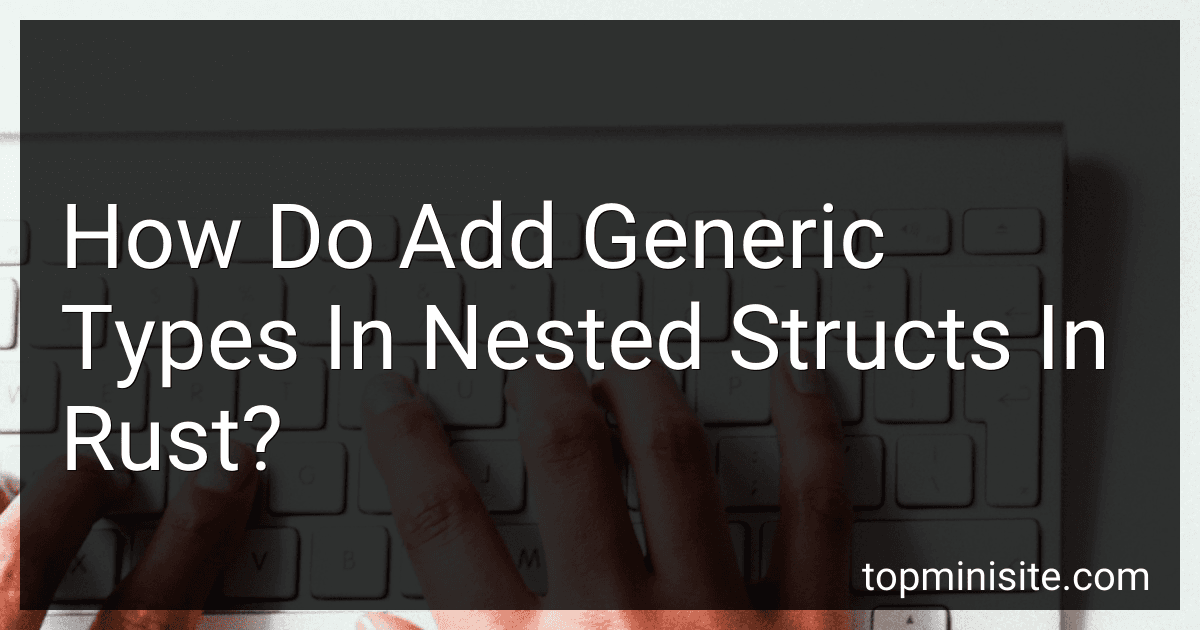Best Rust Programming Books to Buy in January 2026
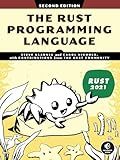
The Rust Programming Language, 2nd Edition


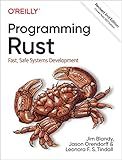
Programming Rust: Fast, Safe Systems Development



Learn Rust Through Projects: 10 Rust Projects That Teach You Everything


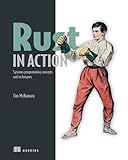
Rust in Action



Effective Rust: 35 Specific Ways to Improve Your Rust Code



Rust Atomics and Locks: Low-Level Concurrency in Practice


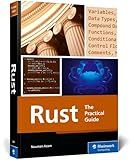
Rust Programming: A Practical Guide to Fast, Efficient, and Safe Code with Ownership, Concurrency, and Web Programming (Rheinwerk Computing)


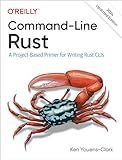
Command-Line Rust: A Project-Based Primer for Writing Rust CLIs



Rust Programming for Beginners: The Complete Guide to Mastering Rust in 30 Days with Hands-On Projects, Quizzes, and Practice Exercises


In Rust, you can add generic types to nested structs by using the same syntax as for regular structs. When defining a nested struct, you can specify one or more generic type parameters inside angle brackets after the struct name.
For example, suppose you have a struct called Container that contains another struct called Item, and you want both of them to be generic over a type T. You can achieve this by defining Container with a generic type parameter T and then defining Item with the same generic type parameter:
struct Container { item: Item, }
struct Item { data: T, }
fn main() { let container = Container { item: Item { data: 42 } }; }
In this example, both Container and Item are generic over type T, allowing you to create instances of these structs with different types depending on the context. By using generic types in nested structs, you can create flexible, reusable data structures that work with a variety of data types.
How do you add generic types to nested structs in Rust?
To add generic types to nested structs in Rust, you can define the generic type parameters at the struct level and then use them within the nested structs. Here is an example to demonstrate how this can be done:
struct Container { data: T, nested: Nested, }
struct Nested { data: T, }
fn main() { let container = Container { data: 5, nested: Nested { data: 10 }, };
println!("Container data: {}", container.data);
println!("Nested data: {}", container.nested.data);
}
In this example, both Container and Nested structs are defined with a generic type parameter T. The generic type T is then used to define the type of the data field within each struct. When creating an instance of Container, you can specify the concrete type for T, and it will be propagated to the nested Nested struct as well.
How to handle generic types with lifetimes in Rust?
In Rust, when working with generic types that include lifetimes, you can use the following syntax to handle them properly:
- Define the generic type with lifetimes in the function signature:
fn example_function<'a, T>(param: &'a T) { // code here }
- Use the lifetime parameter on the generic type inside the function:
fn example_function<'a, T>(param: &'a T) { let result: &'a T = param; // code here }
- If you need to return a reference with a specific lifetime from the function, you can specify it in the return type:
fn example_function<'a, T>(param: &'a T) -> &'a T { param }
By following these guidelines, you can effectively handle generic types with lifetimes in Rust, ensuring that your code is safe and performs as expected.
How to create a nested struct with generic types in Rust?
To create a nested struct with generic types in Rust, you can define a generic type parameter for the outer struct and then use that generic type parameter in the definition of the nested struct. Here's an example:
struct OuterStruct { inner_struct: InnerStruct }
struct InnerStruct { data: T }
fn main() { let outer = OuterStruct { inner_struct: InnerStruct { data: 42 } };
println!("{}", outer.inner\_struct.data);
}
In this example, OuterStruct is a struct with a generic type parameter T, and it contains an InnerStruct with the same generic type parameter. When creating an instance of OuterStruct, you specify the concrete type that T should be, and this type is then used for the nested InnerStruct.
You can also specify different generic type parameters for the outer and inner struct if needed. Just like with regular structs, you can define methods and implement traits for nested structs with generic types as well.
What is the impact of generic types on code performance in Rust?
In Rust, using generic types can have a minimal impact on code performance compared to using concrete types. This is because Rust's compiler is able to optimize generic code at compile time through monomorphization, which means that the compiler generates specialized versions of the generic code for each concrete type used in the program. This eliminates the overhead of generics at runtime, resulting in similar or even better performance compared to using concrete types.
However, using generics can lead to increased code size, as each specialized version of the generic code needs to be generated and included in the final executable. This can potentially impact the compilation time and the size of the resulting binary. Additionally, using complex generic types or implementing generic code in certain ways can introduce additional constraints on the compiler's ability to optimize the code, possibly resulting in decreased performance.
Overall, while using generic types in Rust may have some impact on code performance, the benefits of code reuse, flexibility, and maintainability usually outweigh any potential performance drawbacks. It is important to consider the trade-offs and carefully design generic code to ensure optimal performance in Rust applications.
How to create a nested struct in Rust?
In Rust, you can create nested structures by defining a struct within another struct. Here is an example of how to create a nested struct in Rust:
struct InnerStruct { inner_field: i32, }
struct OuterStruct { outer_field: i32, inner: InnerStruct, }
fn main() { let inner = InnerStruct { inner_field: 10 }; let outer = OuterStruct { outer_field: 20, inner: inner };
println!("Outer field: {}", outer.outer\_field);
println!("Inner field: {}", outer.inner.inner\_field);
}
In this example, InnerStruct is defined within OuterStruct, creating a nested structure. You can then create instances of both the inner and outer struct and access their fields as needed.
How to create a generic type that can work with multiple data types in Rust?
In Rust, generic types can be created by using the angle bracket syntax <T> to declare a type parameter that can be used in the definition of a struct, function, or trait. This type parameter can represent any type and allows the code to be more flexible and reusable.
Here is an example of how to create a generic type in Rust:
// Define a generic struct that can hold a value of any type T struct Container { value: T, }
// Implement a method on the generic struct impl Container { fn new(value: T) -> Self { Container { value } }
fn get\_value(&self) -> &T {
&self.value
}
}
fn main() { // Create instances of the Container struct with different data types let container1 = Container::new(5); let container2 = Container::new("hello");
// Access the values stored in the containers
println!("Value in container1: {}", container1.get\_value());
println!("Value in container2: {}", container2.get\_value());
}
In this example, the Container struct is defined as a generic type with a type parameter T. The new method creates a new instance of the struct with a specified value, and the get_value method returns a reference to the value stored in the container.
By using generic types, you can create code that is more flexible and can work with multiple different data types without needing to duplicate code.
